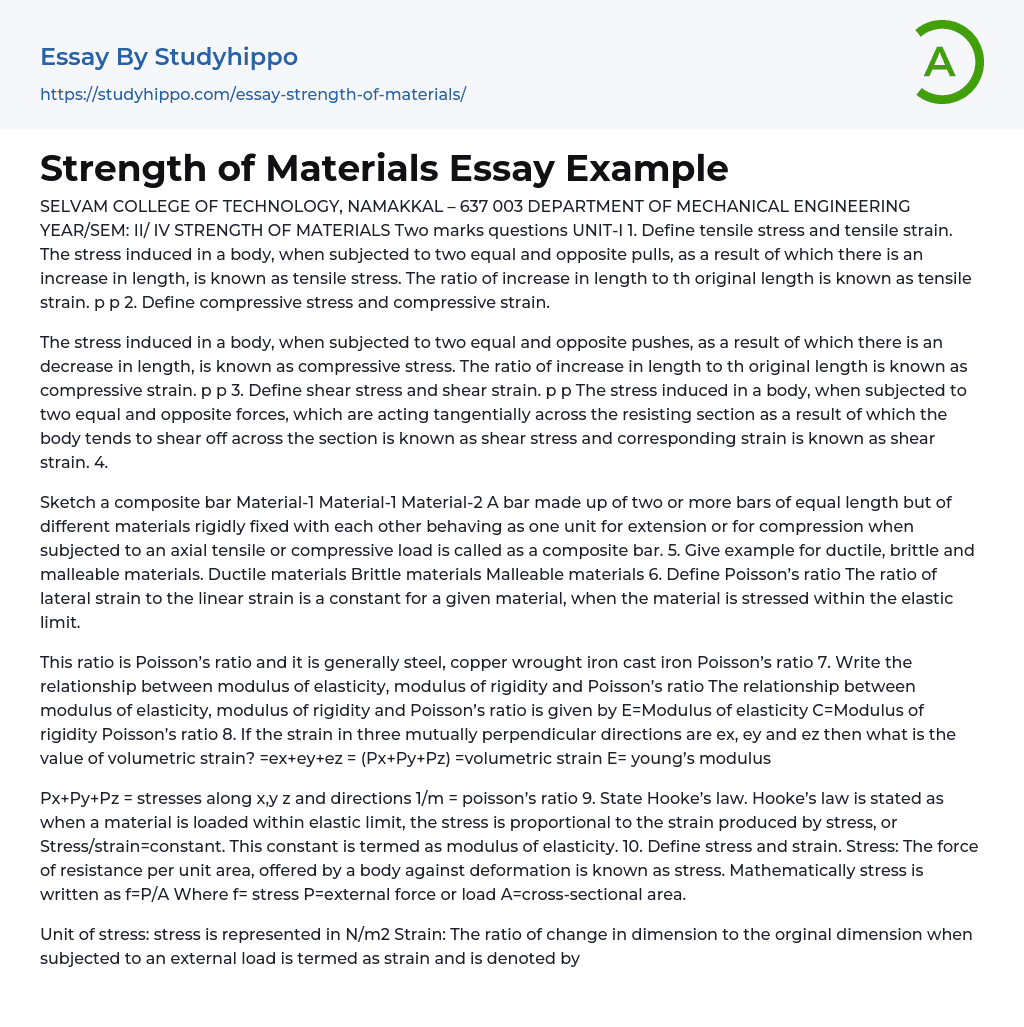

Strength of Materials: Questions and Answers Essay Example
Define tensile stress and tensile strain. The stress induced in a body, when subjected to two equal and opposite pulls, as a result of which there is an increase in length, is known as tensile stress. The ratio of increase in length to th original length is known as tensile strain.
Define compressive stress and compressive strain. The stress induced in a body, when subjected to two equal and opposite pushes, as a result of which there is an decrease in length, is known as compressive stress. The ratio of increase in length to th original length is known as compressive strain.
Define shear stress and shear strain. The stress induced in a body, when subjected to two equal and opposite forces, which are acting tangentially across the resisting section as a result of which the body tends to shear off across the section is known as she
...ar stress and corresponding strain is known as shear strain.
Sketch a composite bar Material-1 Material-1 Material-2 A bar made up of two or more bars of equal length but of different materials rigidly fixed with eac other behaving as one unit for extension or for compression when subjected to an axial tensile or compressive load is called as a composite bar.
Give example for ductile, brittle and malleable materials. Ductile materials Brittle materials Malleable materials Define Poisson’s ratio The ratio of lateral strain to the linear strain is a constant for a given material, when the material is stressed within the elastic limit. This ratio is Poisson’s ratio and it is generally steel, copper wrought iron cast iron Poisson’s ratio
Write the relationship between modulus of elasticity, modulus of rigidity and Poisson’s
ratio The relationship between modulus of elasticity, modulus of rigidity and Poisson’s ratio is given by E=Modulus of elasticity C=Modulus of rigidity Poisson’s ratio If the strain in three mutually perpendicular directions are ex, ey and ez then what is the value of volumetric strain? =ex+ey+ez = (Px+Py+Pz) =volumetric strain E= young’s modulus Px+Py+Pz = stresses along x,y z and directions 1/m = poisson’s ratio
State Hooke’s law. Hooke’s law is stated as when a material is loaded within elastic limit, the stress is proportional to the strain produced by stress, or Stress/strain=constant. This constant is termed as modulus of elasticity. 10. Define stress and strain. Stress: The force of resistance per unit area, offered by a body against deformation is known as stress. Mathematically stress is written as f=P/A Where f= stress P=external force or load A=cross-sectional area. Unit of stress: stress is represented in N/m2 Strain: The ratio of change in dimension to the orginal dimension when subjected to an external load is termed as strain and is denoted by e. It has no unit.
Define modulus of rigidity The ratio of shear stress to the corresponding shear strain when the stress is within the elastic limit is known as modulus of rigidity or shear modulus and is denoted by C or Gor N = 12. Define modulus of elasticity. The ratio of tensile stress or compressive stress to the corresponding strain is known as modulus of elasticity or young’s modulus and is denoted by E. =E 13. Define Bulk modulus.
When a body is subjected to an uniform direct stress in all the three mutually perpendicular directions, the ratio of the direct stress to the
corresponding volumetric strain is found to be a constant is called as the bulk modulus of the material and is denoted by K. K= 14. Define longitudinal strain and lateral strain. = Longitudinal strain: longitudinal strain is defined as the deformation of the body per unit length in the direction of the applied load. Longitudinal strain= Where L= length of the body. P= tensile force acting on the body dL= increase in the length of the body in the direction of P 15.
- Organic Chemistry essays
- Acid essays
- Calcium essays
- Chemical Bond essays
- Chemical Reaction essays
- Chromatography essays
- Ethanol essays
- Hydrogen essays
- Periodic Table essays
- Titration essays
- Chemical reactions essays
- Osmosis essays
- Carbohydrate essays
- Carbon essays
- Ph essays
- Diffusion essays
- Copper essays
- Salt essays
- Concentration essays
- Sodium essays
- Distillation essays
- Amylase essays
- Magnesium essays
- Acid Rain essays
- Agriculture essays
- Albert einstein essays
- Animals essays
- Archaeology essays
- Bear essays
- Biology essays
- Birds essays
- Butterfly essays
- Cat essays
- Charles Darwin essays
- Chemistry essays
- Dinosaur essays
- Discovery essays
- Dolphin essays
- Elephant essays
- Eli Whitney essays
- Environmental Science essays
- Evolution essays
- Fish essays
- Genetics essays
- Horse essays
- Human Evolution essays
- Isaac Newton essays
- Journal essays
- Linguistics essays
- Lion essays



